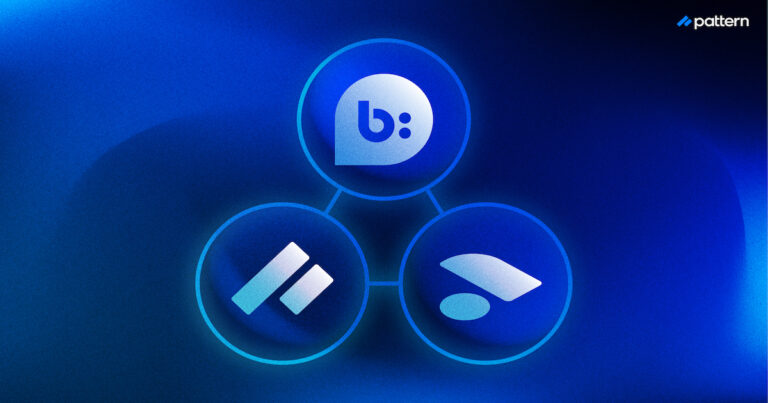2020 and 2021 was a monumental period for the retail sector. Consumers suddenly embraced ecommerce, due to worldwide COVID-19 restrictions. Now that restrictions have eased and physical stores have reopened, many retailers are experiencing a drastic decline in online web traffic. Research shows that traffic to online ecommerce and grocery shopping sites fell 15% in the first five months of 2022, compared to 2021 levels (SimilarWeb, 2022).
Although shoppers have the option to buy in-store again, the ecommerce boom has still accelerated the rate of ecommerce channel growth. Since consumers are more comfortable purchasing online, maintaining and optimising your ecommerce channels is as pertinent as ever.
Earlier this year, Pattern Senior Strategists Hannah Staveley and Peter Boldt-Christmas hosted a LinkedIn Live to address the shift offline, how brands can tackle declining web traffic, and offer guidance to brands struggling with web traffic.
Who is Affected?
Online-only retailers and marketplace sellers have been hit significantly, due to a lack of channel diversification and an overreliance on online sales channels. Following a wave of success during the pandemic, many brand’s direct-to-consumer (DTC) websites are now experiencing declining web traffic after failing to optimise their operating models and propositions in order to retain consumers.
Depending on the maturity of the pre-pandemic ecommerce landscape in each sector, different industries require different strategies to mitigate the effects of declining web traffic. For instance, whilst Q-commerce (quick commerce) has grown significantly, consumers are still opting to purchase their groceries in-store rather than online. Pattern’s 2022 UK Shopper Report supports this trend, indicating consumers were much less likely to use online channels to shop for food, pantry, and alcohol compared to product categories like books and clothing.
Omnichannel Solution for Brands
Strengthening your brand’s omnichannel proposition is essential. In Pattern’s benchmarking research with Google, we found that 75% of retailers and brands improved their omnichannel proposition scores since 2019 showing that they had implemented more of these functionalities, or otherwise improved them (Pattern & Google, 2021).
Brands should raise awareness of their online sales channels, such as their website and app, through a number of offline initiatives, including visible in-store advertisements, providing free in-store WiFi, QR codes on product labels, displays, and advertisements, and providing Click-and-Collect services to mend the division between offline and online spaces.
How to Succeed Exclusively Online
If you have limited control over your offline footprint, or are selling online-only, accelerating your presence on marketplaces can be a strong solution. Marketplaces, such as Amazon, eBay and Tmall, offer a cost-effective and straightforward route to acquiring new customers due to their immense penetration and delivery proposition in the global market – particularly in Europe and Asia. Shoppers are now five times more likely to to search for initial product information on marketplaces than through a brand’s DTC website, according to research from InRiver (Rigby, 2021). 63% of respondents in our 2022 UK Shopper Report stated they visited marketplaces to check the prices of products, and 50% stated they used marketplaces to look for product information, including reviews.
To succeed on marketplaces, brands must differentiate their range and overall proposition from their other sales channels. For example, luxury Whisky maker Macallan surged to number 1 position in terms of revenue within the BWS category on Amazon UK by focusing its listings on premium and limited edition products. Similarly, some of the best-selling and fastest growing spaces within Amazon’s spirits category are low distribution, large format products like magnums and methusalehs. This is likely because many shoppers use Amazon as a gifting destination and are looking for high-end, novelty products. Pattern’s 2022 UK Shopper Report found that 67% of UK shoppers bought gifts on Amazon. Brands can use search and category data to understand where latent consumer demand exists, utilising this as the basis for product differentiation strategy.
Boost Traffic to My Brand
Marketplaces
Keyword research is integral to boosting your brand’s visibility on marketplaces like Amazon. Moving away from a brand defence strategy, to focusing on challenging for placement on the highest volume keywords is an approach that we’ve seen many brands succeed with in the last year. However, thousands of new sellers are joining the platform everyday, making search engine results pages (SERP) placement competition increasingly fierce. Brands must also optimise their product display pages (PDPs) to ensure the improvement of their organic ranking results and conversion rates.
DTC
Due to high customer acquisition costs, the current retail environment is challenging for brands. In order to develop the most appropriate proposition, brands must understand their target shoppers’ needs and behaviours.
During lockdown restrictions, shoppers valued convenience and speed, influencing brands to offer faster and more flexible delivery options (McKinsey & Co., 2022). However, with restrictions eased and economic pressures felt by shoppers, value is being favoured above convenience. Our data shows sites that provide money saving and price comparison tools experience rapid growth in traffic this year. Therefore, evaluating the value that shoppers gain by purchasing from your DTC website is key to maintaining and growing your site traffic.
Value can be provided in a number of ways but needs to be relevant to your target market. Cutting free shipping thresholds, offering 24/7 customer service, providing free samples, free live chat, and other services can all provide your shoppers with value, enhance their shopping experience, and ultimately influence their decision to buy.
Want to learn more?
Watch the full LinkedIn Live discussion.
Accelerate your Ecommerce Strategy with Pattern
As the world’s top ecommerce accelerator, Pattern knows the ins and outs of great ecommerce strategy for global marketplaces. We’re fanatical about data and obsessed with growing our partners’ brand and exceeding sales goals. With custom technology, vast expertise, and highly capable internal teams, we have the resources you need to grow profitability. Ready to explore an accelerator partnership? Contact us here.



